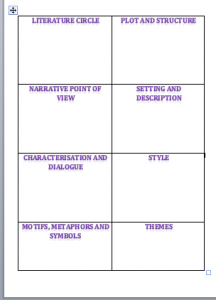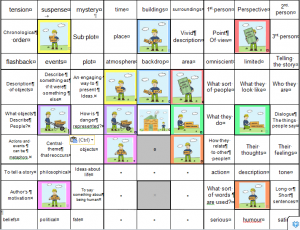Reading Everyone’s a Teacher, Everyone’s a Learner got me thinking about student and teacher participation and the roles between teacher and students. Learning is, and should be, much more participatory than ever. I found myself questioning. Is digital learning really making students collaborate and participate? In my year 8 English we’re using the Pearson e-text and collaborating on our Canvas (LMS) and watching videos. But where is the “participation”? Is it only in online discussions? I use discussions frequently as they are great for hearing the voices of ‘silent’ students and for class discussions sharing our opinions and developing ideas.
The importance of student participation links to a course I’m currently engaged in on functional grammar and how language is related to the context of situation. In particular the aspect of tenor and how the language a student uses changes with their role in the class learning activity.
On Friday I videoed my Year 8 English lesson with the aim of making an annotated film to use as evidence of my teaching for my ePortfolio. I got this frightening idea from Emil Zankov in his presentation on teacher ePortfolios. So I proceeded to set up a camera much to the amusement of my students. This lesson primarily used the Pearson e-text which involved slabs of reading punctuated by me eliciting information and asking concept checking questions and the students taking notes. When I watched the video I realised that although the students were engaged they were static at their computers. Immediately, I wanted to create a more even balance of power in the student-teacher relationship that would be conducive to learning, where students felt comfortable to give opinions, hypothesise, and initiate topics and to take responsibility and to take on roles where they would develop a wider range of spoken English.
This Pearson teaching unit is for the next two weeks but it had to be delivered differently because I wanted them to be involved and to use the key-terms of how a story is constructed (from Pearson). I thought that group activities would bring about more discussion between students and when reporting back to the class their language would involve a change in tenor to recount and express ideas. So, how to create opportunities and a variety of roles in which for students would feel empowered and for them to become independent learners?
I organised the students into groups assigning a leader. For the first task I used the visual thinking tool of layering. Students were given an A3 sheet of paper which was divided into sections using the Pearson headings. As a group they read a short story, The Lottery by Shirley Jackson and then analysed it according to the given categories/headings. To do this they had to also read the relevant Pearson information. While moving around the groups I was more of an observer and the students were telling me what they had found out. They were discussing concepts such as characterisation, motif and theme because they had the need to interact, to talk and to share knowledge and understanding to complete the task.
The next day I wanted to build their control and understanding of the new vocabulary and concepts in the short story and in Pearson. I used the silent card shuffle to relate concept words and their descriptors. Through this silent activity the students applied, analysed and evaluated. Then we discussed the final answers and students self-correct and discussed changes.
Both these activities changed the classroom into a more active environment, they were moving around the room, collaborating in groups, and were empowered to control their learning. They stayed involved through using these visual co-operative leaning techniques and I had the opportunity to also move around and talk individually, with them initiating the questions.
In Friday’s class I told the students that they were to create a philographic for homework. On our site they were to watch a video and look at a website on what a philographic is all about . Then choose one of the themes in The Lottery to create their own philographic.
So I await to see their inspiration. on Monday.


